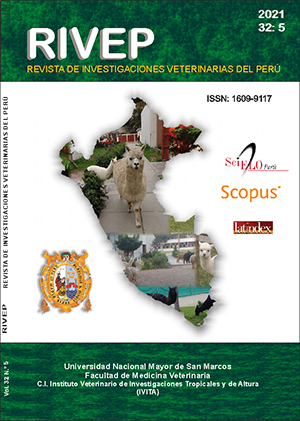Effect of molecular genetic markers on hypoxia-inducible genes of Creole and Brown Swiss cattle raised in the Peruvian Andes
DOI:
https://doi.org/10.15381/rivep.v32i5.21336Keywords:
genome, haplotype, linkage disequilibrium, minor allele frequency, brisket diseaseAbstract
The genomes of 41 bovines of five breeds, existing in the SRA-NCBI database, were used to identify 17 single nucleotide polymorphisms (SNPs) which generate non-synonymous mutations in 10 hypoxia-inducible genes. Of this, only three SNPs located in positions c.1081G>C, c.2089G>A and c.2101G>A of exons 7 and 12 of the EPAS1 gene had different allelic frequencies between beef and dairy cattle (p<0.05). Based on the results of the bioinformatic analysis of the genomes, exonic regions of the EPAS1, NOS2, EPO and VEGFA genes were chosen, which were studied in 60 DNA samples from Creole and Brown Swiss cattle raised in the high Andean region (3213-4309 m above sea level). The cattle were grouped by their haemoglobin concentration (Hb) in Brown Swiss with high Hb (BSHbA) (n=13), Brown Swiss with low Hb (BSHbB) (n=11), Creoles with high Hb (CRHbA) (n=13) and Creoles with low Hb (CRHbB) (n=12); in addition, there was a Brown Swiss group with brisket disease (BSMA) (n=11). The generated amplicons were sequenced with the Sanger methodology, identifying 10 SNPs; however, no associations were found between these SNPs and the groups considered. Only one SNP located at the intronic position Cr.19: 19403681T>C of the NOS2 gene had a different frequency between Creole and Brown Swiss cattle (p<0.05). In addition, that SNP was found linked to two others that are in exon 12 of the same gene.
Downloads
Downloads
Published
Issue
Section
License
Copyright (c) 2021 Gonzalo W. Gonzales Aparicio, Marcos Calderon Montes, Gustavo A. Gutierrez Reynoso, Federico Abel Ponce de Leon Bravo

This work is licensed under a Creative Commons Attribution 4.0 International License.
AUTHORS RETAIN THEIR RIGHTS:
a. Authors retain their trade mark rights and patent, and also on any process or procedure described in the article.
b. Authors retain their right to share, copy, distribute, perform and publicly communicate their article (eg, to place their article in an institutional repository or publish it in a book), with an acknowledgment of its initial publication in the Revista de Investigaciones Veterinarias del Perú (RIVEP).
c. Authors retain theirs right to make a subsequent publication of their work, to use the article or any part thereof (eg a compilation of his papers, lecture notes, thesis, or a book), always indicating the source of publication (the originator of the work, journal, volume, number and date).










